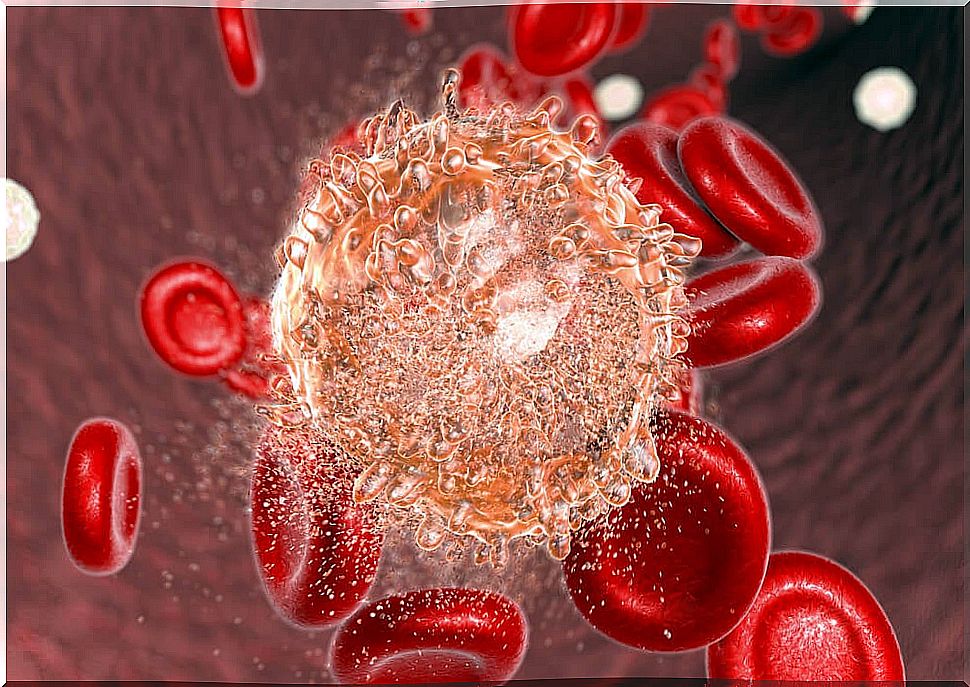First Symptoms Of Acute Lymphoblastic Leukemia
The first symptoms of leukemia develop from different causes. They tend to be non-specific symptoms so they do not allow an instant diagnosis of this disease.
Acute lymphoblastic leukemia is a neoplastic disease, that is, a type of cancer. This form of leukemia is the most common childhood cancer, accounting for 80% of childhood neoplasms. Unlike other types of tumors, leukemias are not localized as they affect blood cells.
Therefore, although they share common symptoms with solid tumors, in this case the abnormal cells do not form a mass but rather circulate through the bloodstream. It is called lymphoblastic leukemia because it affects blood cells called lymphoid cells, which are what make up the immune system.
Pathogenesis of acute lymphoblastic leukemia

Blood cells are constantly renewed and synthesized in the bone marrow. Bone marrow is a flexible tissue found inside some bones. It is made up of hematopoietic stem cells or stem cells.
These stem cells have the ability to form all blood cells in a process called hematopoiesis. It is a multi-stage process mediated by different molecules known as colony-stimulating factors.
Depending on which factor acts, the cells that are formed will be one or the other. This process in which a stem cell gives rise to other types of cells is called cell differentiation.
Under normal conditions, hematopoiesis is a controlled process. When this control fails due to alterations in genes or mutations, cells grow uncontrollably. In addition, differentiation is slowed down so that normal blood cells do not form but the process ends earlier, giving immature cells called blasts.
These immature cells are the neoplastic cells that cause leukemias. They are synthesized in the bone marrow and are distributed throughout the body through the bloodstream. Depending on the stage that is altered, they will have some characteristics or others.
Hematopoiesis has two great differentiated pathways: the myeloid and the lymphoid lines. When the neoplastic cells are of the myeloid line, it is called myeloblastic leukemia. Similarly, if the affected cells are lymphoid, it is called lymphoblastic leukemia.
The main cells of the immune system are synthesized in the lymphoid line: lymphocytes, which is why these cells are the ones affected in acute lymphoblastic leukemia. There are different types of lymphocytes, depending on which they are altered, several types of acute lymphoblastic leukemia are distinguished.
First symptoms of acute lymphoblastic leukemia

In general, the symptoms are not very specific, so to confirm the leukemia it will be necessary to perform specific tests on the patient.
On the one hand, acute lymphoblastic leukemia (constitutional syndrome) has symptoms common to many types of neoplasms.
- Asthenia.
- Weakness.
- Weightloss.
- Night sweats.
- Anorexia or lack of appetite.
As we have said, all blood cells are synthesized in the bone marrow. In leukemias, the uncontrolled growth of blasts occupies a large part of the bone marrow, so they can prevent other types of cells from forming, such as red blood cells, white blood cells, and platelets.
A decrease in red blood cells prevents oxygen from reaching the tissues adequately, leading to anemia. White blood cells are also part of the immune system, so these patients are at higher risk of infections. This is one of the most serious consequences of leukemias.
When we injure ourselves, platelets contribute, in an important way, to slowing the outflow of blood. If these decrease, the subjects will have a higher risk of bleeding.
As the condition progresses, symptoms arising from the involvement of other organs appear. Some examples are pain in the bones if the infiltration of the bone marrow is significant or lesions in the skin.
Testing enables more accurate data
About 80% of patients have adenopathies, which are swollen lymph nodes. They are oval formations that are part of the immune system and also become inflamed in other circumstances such as infections or other neoplasms.
These symptoms can lead to suspicion of leukemia, but to confirm the condition it is necessary to demonstrate the existence of immature cells in the blood and bone marrow.
To do this, a peripheral blood sample is necessary for viewing under a microscope. It is called a smear, and the characteristics and number of immature cells in the blood can be seen in it.
To check the functional alteration of the bone marrow, a bone biopsy or a bone marrow aspirate can be done. These tests allow you to see cells directly. To speak of acute lymphoblastic leukemia, the blasts must have lymphoid characteristics and account for at least 20% of all cells.
The experts of the Spanish Association Against Cancer (AECC) indicate: “All these symptoms also occur in other diseases and it is the combination of them in a precise way and the alterations in the blood tests, which suggests to the doctor that the person suffers from bone marrow failure ”.








